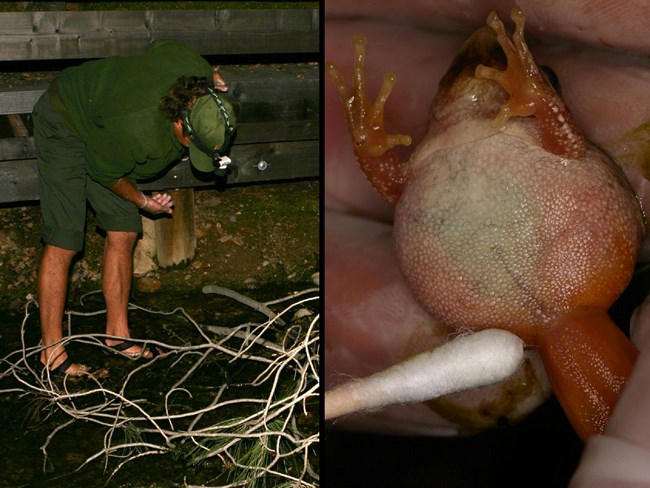
Paul G. Johnson Understanding Amphibian Chytridiomycosis and Its Impact1) What is it? Have you heard about the amphibian die-offs occurring around the world? Many of them appear to be caused by a newly discovered fungus, Batrachochytrium dendrobatidis (Bd). Bd is a member of group of fungi called chytrids, which are usually found underwater growing on dead plant or animal matter. Bd is the only chytrid fungus known to feed on living vertebrates. It primarily affects the skin of amphibians, causing the disease known as amphibian chytridiomycosis. Amphibians breathe and take up water through their skin. Chytridiomycosis interferes with these essential processes. Infected frogs may become lethargic, they are often unable to right themselves if turned upside down, and they may jump or swim in circles. They may rest with their legs outstretched, or sit with their rear end raised up. Sometimes their skin appears bloodshot or sloughs off excessively. They may also sit out in the hot sun, when healthy amphibians would seek shelter in shade or water. 2) Where did it come from?Bd is currently found on every continent where amphibians exist, although in Asia it has only been found in Japan. But nobody is sure where it came from, or how long it has been where it is now. One clue lies in museum specimens, which can be examined for tell-tale signs of skin infection. So far, the oldest known instance is from South Africa in the 1930’s. One hypothesis is that it was spread around the world in African clawed frogs used for human pregnancy tests. 3) Status at Pinnacles, and how are we studying it?In most places, almost as soon as Bd is detected at a new site, the frogs begin dying off. In a period of a few months, frog populations can go from abundant to nearly nonexistent. Most mass die-offs occur soon after frogs transform from tadpoles into frogs, leaving pond or stream shorelines littered with dead frogs. But in some places frogs may be infected even though die-offs are not observed. Pinnacles biologists conducted a study of Bd at Pinnacles National Park from 2006-2007. We tested animals for Bd by swabbing their skin and sending the swabs to a lab for DNA analysis. All three frog and toad species we tested at Pinnacles are infected with Bd: Pacific tree frog, Western toad, and California red-legged frog. We have also found it in foothill yellow-legged frogs and Pacific tree frogs outside the park. Nevertheless, we rarely find dead frogs, and frog populations appear to remain stable. 4) What can you do to help?Chytrid fungus can be transported from place to place in water or mud, including on wet or muddy footwear. You can prevent spreading it by making sure to clean your shoes well and let them dry thoroughly between visits to different places. This is also true for anything else that will come into contact with water. To be extra safe, you can brush items clean and then disinfect them with a weak solution of bleach. Also, you can avoid transporting live animals from one place to another. Release of animals at Pinnacles is prohibited, even if they originally came from Pinnacles, since they may pick up diseases in captivity that can then spread to wild populations. For more information about amphibian disease in California, please visit California Center for Amphibian Disease Control. |
Last updated: October 23, 2024
